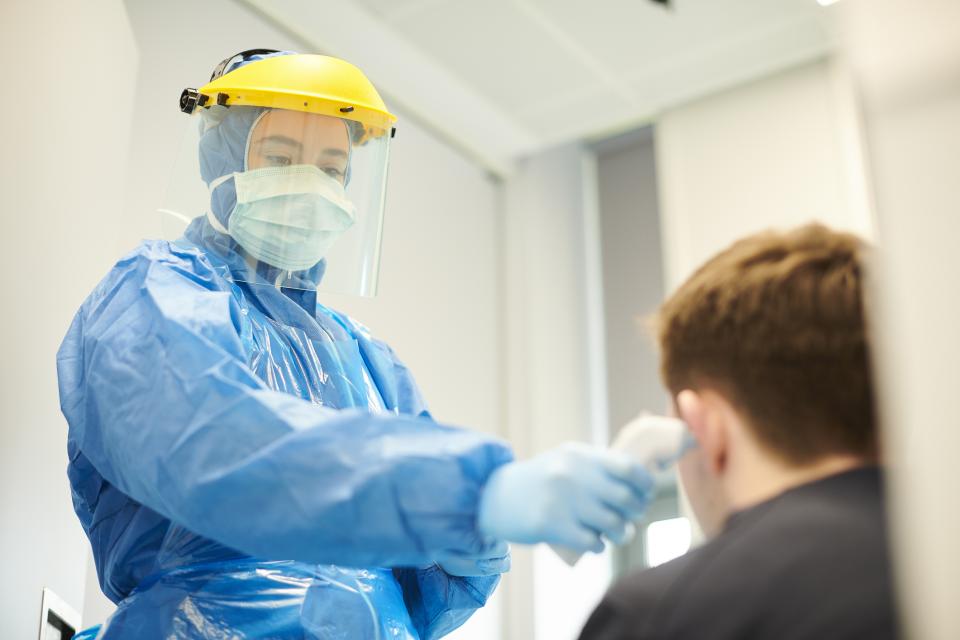
Getty Images
A nurse takes the temperature of a patient.
There is no single best response to COVID-19. What worked in China — a highly centralized and authoritarian country that deployed drones to monitor its citizens — likely will not work in Norway or the U.S. Different countries will need to manage the pandemic with methods that are generally effective, but specifically suited to their culture, their politics, their demographics.
That said, the experiences of several countries close to the initial outbreak spotlight the importance of a few fundamentals in containing COVID-19, along with the value of modern technologies in tracking chains of transmission, explained experts during a recent conference hosted by the Institute for Human-Centered Artificial Intelligence. Emerging successfully on the far side of this crisis, however, will ultimately require countries to connect their individual actions with much broader international cooperation.
Controlling the Spread
Each relying on a different approach, Singapore, South Korea, and Hong Kong have successfully slowed the rate of infection, says Stanford University professor of medicine Michele Barry, who also helms Stanford’s Center for Innovation in Global Health.
Singapore focused on a strategy of strict containment; it tightly controlled its borders, imposed a 14-day quarantine on anyone returning to the country, and even treated those with respiratory infections who tested negative for coronavirus with a five-day quarantine. Those who tested positive were isolated, even from their families, for 14 days.
South Korea focused its resources on “very vigorous testing,” Barry says, providing at the height of the program 100,000 tests per day. Hong Kong, meanwhile, concentrated on ways to reinforce norms of social distancing, like presenting daily public releases of COVID-related information that included block-level data on anyone who tested positive.
These efforts, tightly enforced, were able to very effectively control the spread of COVID-19. They were also augmented by technology. In Singapore, for instance, the government used cellphone GPS data to make sure those under quarantine stayed within prescribed borders. South Korea monitored who came in touch with whom, using information from credit cards and security cameras; the country also monitored hotels and restaurants with thermal imaging cameras, and that way picked febrile individuals out of a crowd.
In Taiwan, says Jason Wang, director of Stanford’s Center for Policy, Outcomes, and Prevention, the government set up a command center for virus-combating operations, checked temperatures of all arriving airline passengers and quarantined those with fevers, linked national health insurance and customs databases, and tracked citizens’ movements.
Though powerful tools in the fight against COVID-19, the use of these technologies raises the difficult calculus of balancing public health and civil liberties.
“We have always had public health laws that take precedence over individual privacy for the public good,” Barry says. “What we’re worried about in more authoritarian countries is that sometimes it’s hard to unroll laws that are made in the time of emergencies.”
“We need to be asking questions about what we’re willing to sacrifice for the public good in moments of crisis, and how we’ll keep an eye on the long-term effects,” says Megan Palmer, the Deputy Director of the Biosecurity Initiative at Stanford’s Freeman Spogli Institute for International Studies.
It’s difficult to make these decisions in a moment of crisis, “so we should make sure we’re building infrastructure early that can manage trade-offs between information sharing and privacy protections.”
Getting Out of Lockdown
Getting a pandemic under control is one thing; emerging on the other side is another. Ami Bera, a medical doctor and U.S. congressman from California, explained the importance of serological testing in resuming the rhythms of normal life.
“Serologic testing will tell us how many people in a community have already potentially been infected by COVID-19, have recovered, and now have some level of immunity,” says Bera. “That will help us make scientifically sound decisions on when we can open up certain parts of a community, or certain parts of the country.” This process, he suggests, will be staggered across the country, and it will likely be “bifurcated” within individual communities: Restrictions placed on vulnerable populations may differ from those placed on the general population.
International Coordination
In the long term, Barry describes the importance of laying groundwork for detecting the next pandemic. “We need to have a concept of interdependent sovereignty and of shared global governance,” Barry says. Akin to air pollution and climate change, pandemics don’t respect national borders. International coordination is required to monitor for outbreaks and to address issues, like deforestation, that increase the probability of outbreaks. Funding for the World Health Organization also needs to be increased. “Its budget, for the entire world, is similar to the budget for a large teaching hospital in the United States,” she says. “We’re all in this together as a planet, and we can’t forget that.”
Missed the conference? Watch the conference recording, and check the HAI blog for additional in-depth coverage. Also, sign up for HAI’s email newsletter to learn about upcoming events.